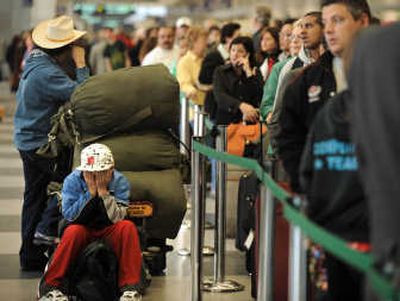Airline travelers in for another summer of delays

WASHINGTON – Travelers finally shaking off bad memories of endless airline delays last summer are likely in for an unpleasant reminder of that terminal and tarmac pain.
That’s the prognosis the Transportation Department’s inspector general delivered to lawmakers Wednesday, as he urged regulators, airlines and airports to keep trying to ease congestion but warned their efforts will likely fall short before the busy summer season starts.
Weather conditions, the effects of a softening economy and higher fuel prices on the industry – including carriers’ efforts to reduce capacity – and the effectiveness of government initiatives at congested airports all can play a role in easing delays.
But several busy airports – including the three New York-area airports, Chicago’s O’Hare and Minneapolis-St. Paul – must be watched “closely this summer because of severe peaking during part of the day,” Inspector General Calvin L. Scovel III said at the hearing of the House aviation subcommittee.
“Northwest Airlines has scheduled 56 departures in one 15-minute window at Minneapolis-St. Paul, nearly three times the airport’s departure capacity for that window,” Scovel said.
Committee Chairman Jerry Costello, D-Ill., asked why an airline would do such a thing. Air Transport Association President and chief executive James May said he had no answer.
That likely came as little surprise to lawmakers, given the volume of flying horror stories, both their own and those of constituents, they aired at the hearing.
More than 31 percent of commercial flights in the U.S. arrived late, were canceled or diverted in February, the Transportation Department said last week, and on-time arrival results in 2007 were the second-worst on record.
The hearing came as an estimated 100,000 passengers scrambled to book new plans after American Airlines canceled more than 1,000 flights due to jet-wiring inspections.
Scovel’s “after action” report on last summer’s delays showed some progress had been made by the Federal Aviation Administration, airlines and airports in implementing customer service recommendations that his office made last September. But much work remains to be done.
He criticized the airline industry, in particular, for not following a recommendation to establish uniform limits for providing service to stranded travelers. That request came after two winter weather-related incidents last year when hundreds of passengers were stuck on planes on the tarmac for up to 10 1/2 hours.
While all but one of the nation’s largest 12 airlines have defined an “extended period of time … for meeting passengers’ essential needs,” the trigger thresholds vary from 30 minutes to two hours on arrival, and from 90 minutes to three hours on departure. The thresholds for deplaning passengers stuck on a plane vary from 30 minutes to five hours on arrival, and between one and five hours on departure.
“We think it is unlikely that passengers’ definition of an extended period of will vary depending upon which airline they are flying,” Scovel said.
Only a third of the airlines completely satisfied the recommendation to establish specific targets for reducing chronically delayed or canceled flights. “Unfortunately, many airlines are losing an opportunity to educate the public on the efforts they are taking to reduce delays,” Scovel said.
Scovel’s current recommendations for easing delays this summer include:
•The DOT needs to negotiate a plan with the Defense Department for use of military airspace this summer, following similar action taken during the last Thanksgiving holiday period.
•The FAA needs to continue to address concerns about air traffic controller productivity and excess spacing on final approach while training large numbers of new controllers.
•The airlines should attempt to level out the arrival and departure banks at their large-hub airports to create more manageable flight operations at peak times.
•The airports need to work with the FAA to improve procedures governing efficient use of taxi-ways and runways.